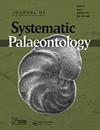Taxonomy, phylogeny and stratigraphical ranges of middle Permian pareiasaurs from the Karoo Basin of South Africa
IF 2.2
2区 地球科学
Q3 EVOLUTIONARY BIOLOGY
引用次数: 2
Abstract
Pareiasaurs were relatively abundant, globally-distributed, herbivorous parareptiles of the mid to late Permian. The basal-most forms, all members of the Bradysauria, are restricted to the Guadalupian (mid-Permian) of South Africa and went extinct in the late Capitanian near the top of the Tapinocephalus Assemblage Zone. Currently four species are recognized in this group: Bradysaurus seeleyi, B. baini, Embrithosaurus schwarzi and Nochelesaurus alexanderi. These taxa have been poorly defined historically and based on a limited number of specimens, leaving the taxonomic diversity of the group open to doubt and limiting their utility in biostratigraphy. Here, we present our fourth and final contribution to improve the understanding of this group by providing a taxonomical and phylogenetic review, updated stratigraphical ranges, and updated diagnoses for each taxon within Bradysauria. Bradysaurus seeleyi is synonymized with Bradysaurus baini, resulting in three valid mid-Permian pareiasaur taxa: Bradysaurus baini, Embrithosaurus schwarzi and Nochelesaurus alexanderi. Our cladistic analysis of cranial and postcranial characters supports the monophyly of Bradysauria with five synapomorphies. Embrithosaurus schwarzi is recovered as the sister taxon to a clade containing Bradysaurus baini and Nochelesaurus alexanderi. By identifying 157 pareiasaur specimens in fossil collections we show that the Bradysauria are stratigraphically restricted to the Abrahamskraal Formation of the Beaufort Group and suggest a staggered appearance. Bradysaurus baini is first to appear, followed by Nochelesaurus alexanderi, and lastly by Embrithosaurus schwarzi. All three taxa perished during the Capitanian mass extinction, and have their highest occurrences near the top of the Abrahamskraal Formation.南非卡鲁盆地中二叠世准牙龙的分类、系统发育和地层范围
帕雷亚龙是二叠纪中晚期数量相对丰富、分布在全球的草食性副爬行动物。最基底的形态,所有Bradysauria的成员,仅限于南非的Guadalupian(二叠纪中期),并在Capitanian晚期Tapinocephalus组合带顶部附近灭绝。目前,该群中有四个物种:塞氏Bradysaurus seeleyi、B.baini、schwarzi Embritosaurus和alexanderi Nochelesaurus。这些分类群在历史上的定义很差,并且基于数量有限的标本,这使得该类群的分类多样性受到质疑,并限制了它们在生物地层学中的应用。在这里,我们提出了我们的第四个也是最后一个贡献,通过提供Bradysauria中每个分类单元的分类和系统发育综述、更新的地层范围和更新的诊断,来提高对这一群体的理解。赛莱伊Bradysaurus seeleyi与拜尼Bradysauus baini同义,产生了三个有效的二叠纪中期准牙龙分类群:拜尼Bradys aurus baini、施瓦兹Embritosaurus schwarzi和亚历山大诺切莱萨龙。我们对颅内和颅后特征的分支系统分析支持有五种突触形态的慢尿症的单系性。施瓦兹Emblithosaurus schwarzi被恢复为包含白氏Bradysaurus baini和亚历山大诺切莱萨龙的分支的姐妹分类单元。通过鉴定化石收藏中的157个帕雷亚龙标本,我们表明Bradysauria在地层上仅限于Beaufort群的Abrahamskraal组,并表明其外观交错。首先出现的是白氏Bradysaurus baini,其次是亚历山大诺切莱萨龙,最后是施瓦兹Embritosaurus schwarzi。这三个分类群都在凯德阶大灭绝期间灭绝,在亚伯拉罕克拉尔组顶部附近出现次数最多。
本文章由计算机程序翻译,如有差异,请以英文原文为准。
求助全文
约1分钟内获得全文
求助全文
来源期刊
CiteScore
5.30
自引率
7.70%
发文量
31
审稿时长
>12 weeks
期刊介绍:
The Journal of Systematic Palaeontology publishes papers that provide novel and impactful results in phylogenetics and systematics and that use these results in ways that significantly advance rigorous analyses of palaeogeography, palaeobiology, functional morphology, palaeoecology or biostratigraphy. Papers dealing with theoretical issues or molecular phylogenetics are also considered if they are of relevance to palaeo-systematists. Contributions that include substantial anatomical descriptions, descriptions of new taxa or taxonomic revisions are welcome, but must also include a substantial systematics component, such as a new phylogeny or a revised higher-level classification. Papers dealing primarily with alpha-taxonomic descriptions, the presentation of new faunal/floristic records or minor revisions to species- or genus-level classifications do not fall within the remit of the journal.

 求助内容:
求助内容: 应助结果提醒方式:
应助结果提醒方式:


